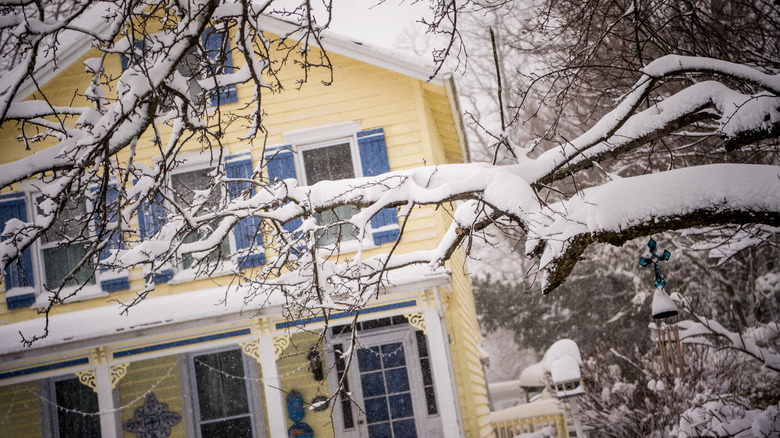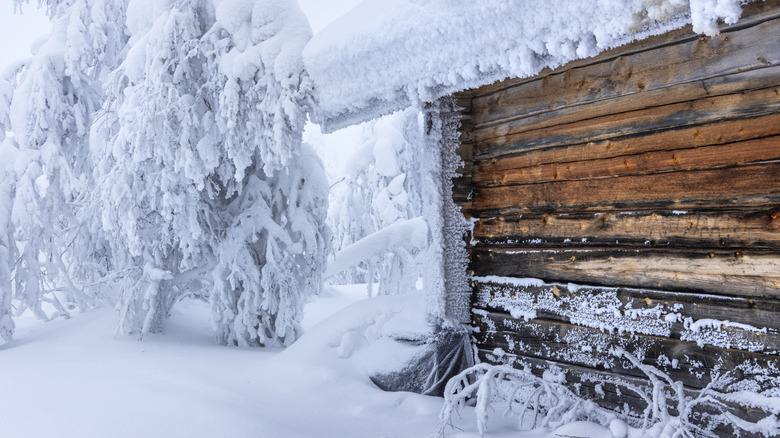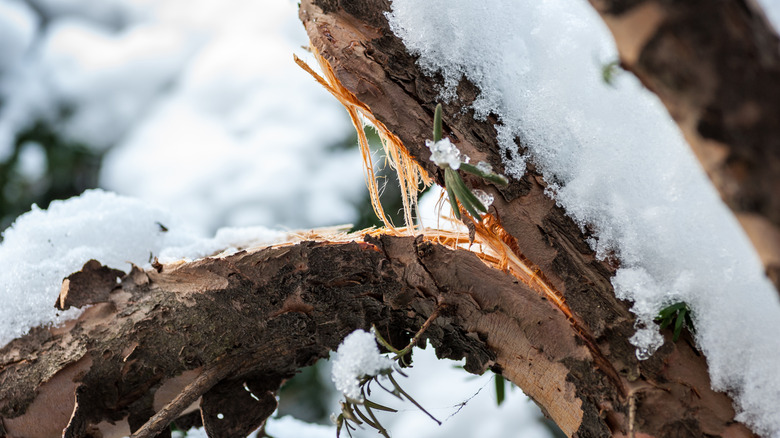Everything You Need To Know About Caring For Snow-Damaged Trees
We may receive a commission on purchases made from links.
Winter weather can be brutal on limbs, but it's not always your limbs — the chapped hands and frozen toes — that suffer. Sometimes the long winter, and the seemingly endless snow, can be detrimental to the limbs, roots, and overall health of your trees. If you've been experiencing an insufferable winter, and are beginning to worry if your trees have sustained some injuries — we'll share everything you need to know about caring for snow-damaged trees. We can't do much about the snow-laden clouds that are ready to pile on more of the frosty stuff, but you'll feel better knowing that there's hope for your trees. It begins by knowing how to tell if your trees are damaged, what you can do about it, and what you may be able to do to prevent future damage.
The signs of winter injury to your trees and shrubs will be more apparent once you're able to get outside to examine them. While a cracked, deeply split, or obviously broken branch is unmistakably damaged, you might not realize the bark damage that encircles a branch could also be a sign of winter trauma to the tree. And while the heaviness of snow and the broken branches it causes are the most common worries, don't forget that with snow comes frigid air that can lead to low-temperature injuries or desiccation, which happens to trees that lose water through transpiration but can't replace it because the ground is frozen. Some of this damage can be fixed by you, but some of it can be lethal or a job for an arborist.
What to do when the snow finally stops and when to get the saw
It's tempting to take immediate action when you see a cracked branch or one bending low, burdened by a heavy pile of snow or ice. After all, unless you have a limber pine (Pinus flexilis), the hardy pine tree with a unique adaptation that makes it resilient to snow and ice, you may have reason to worry. It can bend nearly in half without breaking, but most others cannot! If the trees are in the throes of a winter storm, many experts will advise you to leave tree branches covered with snow alone. Don't rush out to "free" your tree of its snow prison because you'll risk additional breakage and remove the insulating protection of snow or ice. And you should never shake the tree. The only exception is to use a broom to gently brush upward on heavy snow that is bending a branch.
The toughest decision for a homeowner with a snow-damaged tree is to determine whether or not to prune the broken or damaged branch. Do not rush the decision. If the branch hasn't completely separated from the tree or is not a potential safety concern (it isn't hanging over a sidewalk, door, or driveway), it may still recover. So take the time to weigh the facts. How much of the branch is still intact? Is it just a crack or a deeper, jagged, lengthy, near-total break? Is the tree otherwise healthy? Is it a younger tree? (Just like people, younger trees recover more quickly). Is there additional damage elsewhere or just to the one branch?
When to call in the pros and when to let the tree heal
For the best chance of successfully cutting off a branch, use appropriate, well-sharpened equipment, and be sure to use protective eyewear and gloves. But even if you know how to prune your trees the right way without calling a pro, be realistic before you grab your saw. If you need a ladder or if the branch is especially large, close to utility lines, or could fall where additional damage to a home, car, or other structure could be sustained, then it's time to call a professional arborist. With some snow-caused injuries to your tree, you need to call in the professionals anyway because the damage can't be solved with a saw. Low-temperature damage, sun scald, and deep cracks in the base of the tree may benefit from an arborist's trained eye and care advice.
Otherwise, some damage may even heal on its own depending on the severity of the wound and the introduction of any disease. For example, if sun scald creates a wound, gently remove only the dead bark. To combat freezing temperatures that lead to desiccation, winter-damaged trees will appreciate heavy watering and the addition of a complete fertilizer when spring arrives.
Preventing desiccation and more stress can easily be accomplished by watering heavily in the fall before the ground freezes. When it comes to preventing broken limbs, you might be able to protect some of your smaller trees from snow damage by tying them with something like these Saintrygo Adjustable Flat Bungee Cords. Choose a material that won't break or dig into the tree.


